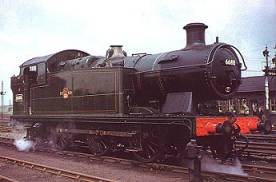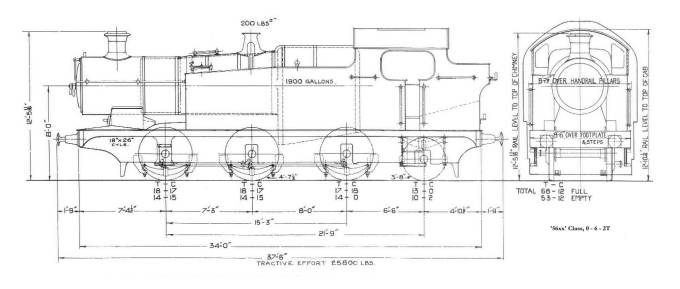GWR '56XX' Class 0-6-2T - 6686
The smaller railway companies which operated in South Wales in the
first two decades of the 19th Century found that the best type of locomotive
for hauling the long trains of coal from pit-head to the docks was the
0-6-2T. When the Great Western
Railway was expanded in 1921 to include these smaller
companies there was a need to introduce a more modern version of the traditional
valleys tank engine. The Chief Mechanical Engineer of the Great
Western
Railway, C. B.
Collett introduced the 56XX Class
in 1924 & over the next 5 years 200 locomotives of the class were
built. Most were built at Swindon, but in 1928, Swindon works was busy & a
batch of locomotives were built at the works of Armstrong Whitworth in
Newcastle-Upon-Tyne. No.6686 was one of this batch, being completed in September
1928. It spent all its life in South Wales, mainly based in Duffryn Yard
Locomotive Shed at Port Talbot & worked on freight & branch passenger
trains in that area. It was withdrawn from service in April 1964.
Most of the locomotives used to
transport coal in South Wales in the early 1920's were of
 the
0-6-2 tank design as the Rhymney, Taff & Barry Railways had used this
configuration for some years. After grouping in 1922 & new engines were
required by the GWR, it was decided that this was arrangement was best suited
for the work & the working conditions, & so Charles
Collett designed the '5600' class.
the
0-6-2 tank design as the Rhymney, Taff & Barry Railways had used this
configuration for some years. After grouping in 1922 & new engines were
required by the GWR, it was decided that this was arrangement was best suited
for the work & the working conditions, & so Charles
Collett designed the '5600' class.
The first engine built was number
5600 - no prototype was needed - & was constructed using many standard Great
Western parts such as Standard number 2 boiler, 4 feet 7½ inch driving wheels &
the 3 feet 8 inch trailing wheel. One striking detail of the class was the
smokebox overhang which ended at the buffer beam.
Production continued with minor
detail alterations, for example parallel buffers replaced the tapered type &
balance weights fitted inside the driving wheels webs opposite the crank pin.
The last batch of the class was built
by Armstrong Whitworth between August & October 1928. One feature of this
class is that they ran better in reverse than in forward gear, making the
trailing wheel into a bogie wheel.
Modification
Some engines built by
Armstrong Whitworth were modified by Swindon for noisy brakes. From 1934, the
class were fitted with recesses in the rear of the bunker, & later on, sliding
screens were fitted to the cab sides.
Withdrawal
The first withdrawals of the
class were four locomotives in May 1962, while the last engine in service was
6668 which survived until the last month of GWR steam, December 1965.
Preservation
Due to these engines working
in Wales, eight of the nine preserved examples were taken to Dai Woodham's yard
at Barry after withdrawal. The nine preserved engines are numbers 5619, 5637,
5643, 5668, 6619, 6634, 6686, 6695 & 6697.
Running numbers: 5600
- 5699, 6600 - 6699.
Built: 1924-7 (5600 - 5699, built by GWR), 1927-8 (6600 -
6649, built by GWR), 1928 (6650 - 6699,
built by Armstrong Whitworth).
|
Specifications |
| Cylinders
|
(2)
18 x 26 inches
|
Driving
wheel diameter
|
4
feet 7½ inches
|
| Trailing
wheel dia
|
3
feet 8 inches
|
Tractive
Effort
|
25,800
pounds
|
| Boiler
type
|
Number
2
|
Boiler
maximum dia.
|
5
feet 0½ inches
|
| Boiler
minimum dia.
|
4
feet 5 1/8 inches
|
Fire
tubes, no. & dia.
|
218
x 1 5/8 inches
|
| Flue
tubes, no. & dia.
|
6
x 5 1/8 inches
|
Superheater
tubes, no. & dia.
|
36
x 1 inch
|
| Boiler
pressure
|
200
lbs/square inch.
|
Boiler
length
|
11
feet 0 inches
|
| Area
of firegrate
|
20.35
square feet
|
Heating
surfaces, tubes
|
1,144.94
square feet
|
| Heating
surfaces, firebox
|
121.8
square feet
|
Heating
surfaces, superheater
|
82.2
square feet
|

In 1987 an initial survey was carried out to assess the
condition with the aim of establishing the priority for restoration. Brief
details of this survey are as follows :-
| Item |
Description of Condition |
| Front tube plate |
Not too bad, may need small areas to be welded |
| Front of boiler |
Good where seen |
| Back of boiler |
Good where seen |
| Copper tube plate |
Several rivets in laps to renew |
| Back tube plate |
Several rivets in laps to renew |
| Copper side plates |
Satisfactory |
| Crown |
Satisfactory |
| Smokebox |
Good |
| Crown Stays |
To be examined after removal of tubes for access to
barrel |
| Stays |
To be examined after removal of tubes for access to
barrel |
| Tubes |
To be renewed |
| Asbestos |
There is a small amount of asbestos in cab |
| Barrel |
Several small patches to be welded |
| Tanks |
Needs patching repairs |
| Bunker |
Needs patching repairs |
 the
0-6-2 tank design as the Rhymney, Taff & Barry Railways had used this
configuration for some years. After grouping in 1922 & new engines were
required by the GWR, it was decided that this was arrangement was best suited
for the work & the working conditions, & so Charles
Collett designed the '5600' class.
the
0-6-2 tank design as the Rhymney, Taff & Barry Railways had used this
configuration for some years. After grouping in 1922 & new engines were
required by the GWR, it was decided that this was arrangement was best suited
for the work & the working conditions, & so Charles
Collett designed the '5600' class.